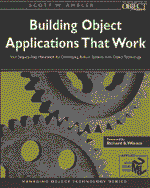 Building Object Applications that Work
Building Object Applications that Work Book contents
- Frontmatter
- Contents
- About the Author
- Foreword
- Preface
- Acknowledgments
- Part I INTRODUCTION TO BUILDING OBJECT APPLICATIONS
- Part II OBJECT-ORIENTED ANALYSIS, DESIGN, AND ARCHITECTURE
- Part III OBJECT-ORIENTED CONSTRUCTION
- Part IV OBJECT-ORIENTED TESTING
- Part V CONCLUSION
- Chapter 13 Where to Go from Here—Personal Success Strategies
- APPENDICES
- Index
Chapter 13 - Where to Go from Here—Personal Success Strategies
from Part V - CONCLUSION
Published online by Cambridge University Press: 07 September 2010
- Frontmatter
- Contents
- About the Author
- Foreword
- Preface
- Acknowledgments
- Part I INTRODUCTION TO BUILDING OBJECT APPLICATIONS
- Part II OBJECT-ORIENTED ANALYSIS, DESIGN, AND ARCHITECTURE
- Part III OBJECT-ORIENTED CONSTRUCTION
- Part IV OBJECT-ORIENTED TESTING
- Part V CONCLUSION
- Chapter 13 Where to Go from Here—Personal Success Strategies
- APPENDICES
- Index
Summary
What We'll Learn in This Chapter
How to overcome the object-oriented (OO) learning curve.
What we've learned in this book.
By reading this book you've made a really good start at overcoming the OO learning curve, but that's all you've done, made a really good start. There's still a lot of work ahead of you. More reading, courses, mentoring, and lots of development work. There is a light at the end of the OO tunnel, and this chapter tells you how to get there.
As we saw in this book, there's a lot to object-oriented development. On the one hand, the object-oriented learning process can be long and difficult. Furthermore, there is no guarantee for success. On the other hand, you've gotten a really good start at it by reading this book. Now it's time to move on, however, down the never-ending road of continuous learning.
Advice for Overcoming the OO Learning Curve
Pick up some other books. Throughout this book I referred to some really good books. Although each of them takes a different approach to OO development, you'll find that there are several similarities between them. You should seriously consider reading at least one or two of them.
Subscribe to some magazines and/or journals. There are several object-oriented analysis-and-design magazines and journals, as well as numerous OO programming magazines. They provide leading-edge advice regarding OO development techniques. It's really worth your while to start reading some of them.
[…]
- Type
- Chapter
- Information
- Building Object Applications that WorkYour Step-by-Step Handbook for Developing Robust Systems with Object Technology, pp. 419 - 424Publisher: Cambridge University PressPrint publication year: 1997
